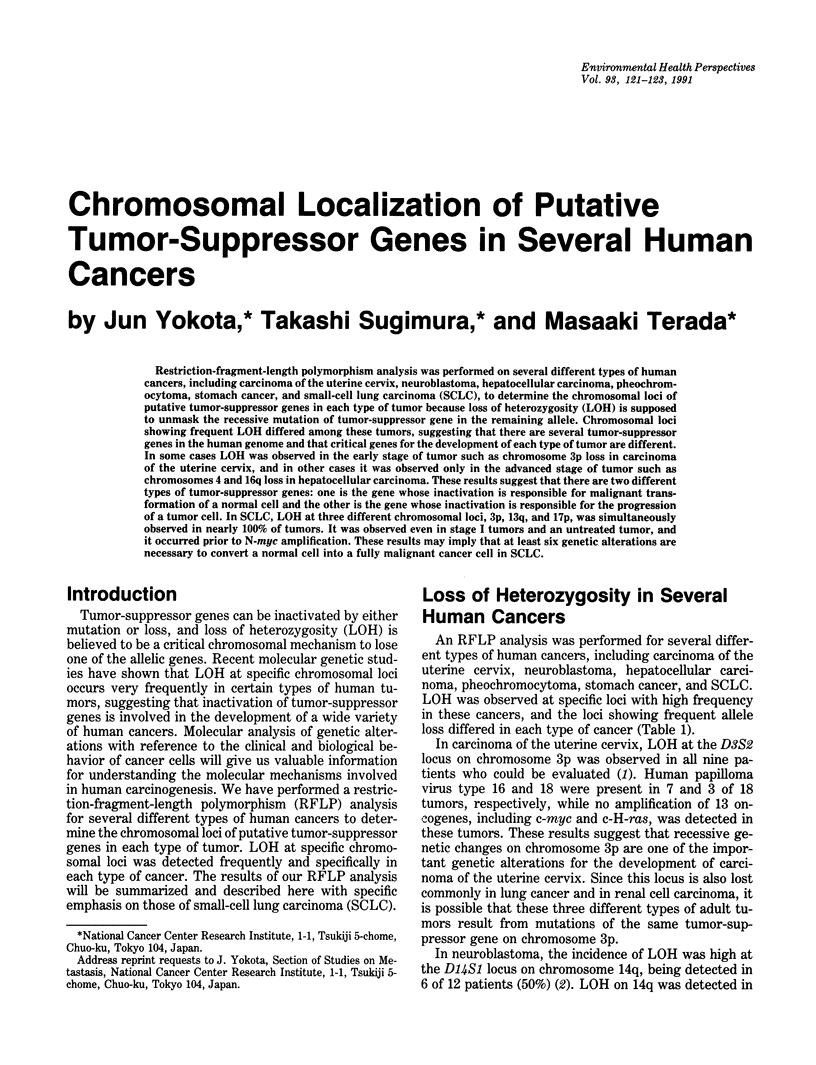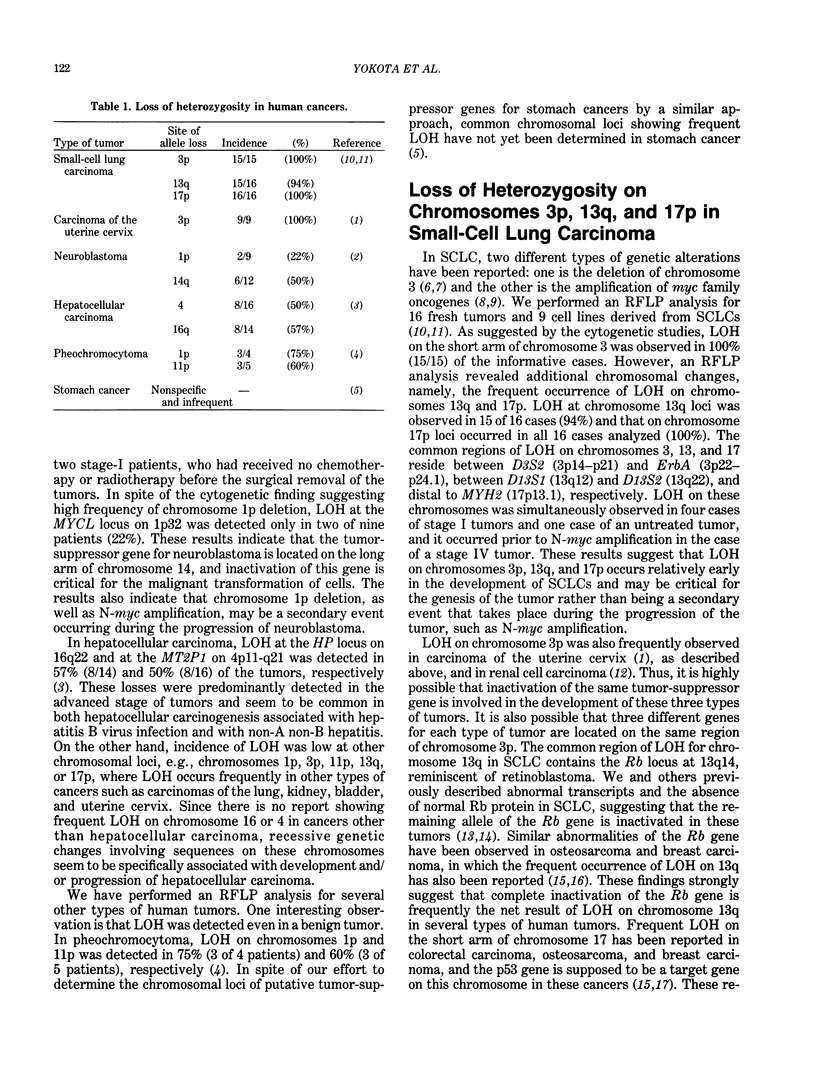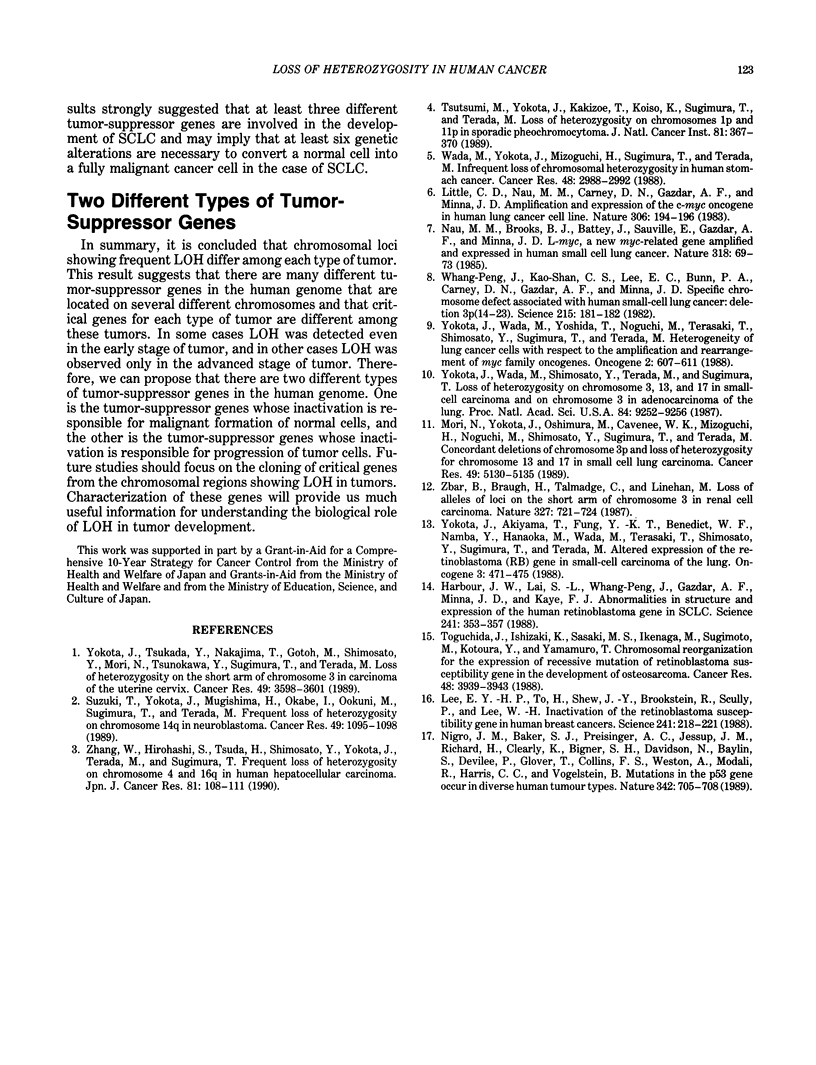Abstract
Restriction-fragment-length polymorphism analysis was performed on several different types of human cancers, including carcinoma of the uterine cervix, neuroblastoma, hepatocellular carcinoma, pheochromocytoma, stomach cancer, and small-cell lung carcinoma (SCLC), to determine the chromosomal loci of putative tumor-suppressor genes in each type of tumor because less of heterozygosity (LOH) is supposed to unmask the recessive mutation of tumor-suppressor gene in the remaining allele. Chromosomal loci showing frequent LOH differed among these tumors, suggesting that there are several tumor-suppressor genes in the human genome and that critical genes for the development of each type of tumor are different. In some cases LOH was observed in the early stage of tumor such as chromosome 3p loss in carcinoma of the uterine cervix, and in other cases it was observed only in the advanced stage of tumor such as chromosomes 4 and 16q loss in hepatocellular carcinoma. These results suggest that there are two different types of tumor-suppressor genes: one is the gene whose inactivation is responsible for malignant transformation of a normal cell and the other is the gene whose inactivation is responsible for the progression of a tumor cell. In SCLC, LOH at three different chromosomal loci, 3p, 13q, and 17p, was simultaneously observed in nearly 100% of tumors. It was observed even in stage I tumors and an untreated tumor, and it occurred prior to N-myc amplification. These results may imply that at least six genetic alterations are necessary to convert a normal cell into a fully malignant cancer cell in SCLC.
Full text
PDF


Selected References
These references are in PubMed. This may not be the complete list of references from this article.
- Harbour J. W., Lai S. L., Whang-Peng J., Gazdar A. F., Minna J. D., Kaye F. J. Abnormalities in structure and expression of the human retinoblastoma gene in SCLC. Science. 1988 Jul 15;241(4863):353–357. doi: 10.1126/science.2838909. [DOI] [PMC free article] [PubMed] [Google Scholar]
- Lee E. Y., To H., Shew J. Y., Bookstein R., Scully P., Lee W. H. Inactivation of the retinoblastoma susceptibility gene in human breast cancers. Science. 1988 Jul 8;241(4862):218–221. doi: 10.1126/science.3388033. [DOI] [PubMed] [Google Scholar]
- Little C. D., Nau M. M., Carney D. N., Gazdar A. F., Minna J. D. Amplification and expression of the c-myc oncogene in human lung cancer cell lines. Nature. 1983 Nov 10;306(5939):194–196. doi: 10.1038/306194a0. [DOI] [PubMed] [Google Scholar]
- Mori N., Yokota J., Oshimura M., Cavenee W. K., Mizoguchi H., Noguchi M., Shimosato Y., Sugimura T., Terada M. Concordant deletions of chromosome 3p and loss of heterozygosity for chromosomes 13 and 17 in small cell lung carcinoma. Cancer Res. 1989 Sep 15;49(18):5130–5135. [PubMed] [Google Scholar]
- Nau M. M., Brooks B. J., Battey J., Sausville E., Gazdar A. F., Kirsch I. R., McBride O. W., Bertness V., Hollis G. F., Minna J. D. L-myc, a new myc-related gene amplified and expressed in human small cell lung cancer. Nature. 1985 Nov 7;318(6041):69–73. doi: 10.1038/318069a0. [DOI] [PubMed] [Google Scholar]
- Nigro J. M., Baker S. J., Preisinger A. C., Jessup J. M., Hostetter R., Cleary K., Bigner S. H., Davidson N., Baylin S., Devilee P. Mutations in the p53 gene occur in diverse human tumour types. Nature. 1989 Dec 7;342(6250):705–708. doi: 10.1038/342705a0. [DOI] [PubMed] [Google Scholar]
- Suzuki T., Yokota J., Mugishima H., Okabe I., Ookuni M., Sugimura T., Terada M. Frequent loss of heterozygosity on chromosome 14q in neuroblastoma. Cancer Res. 1989 Mar 1;49(5):1095–1098. [PubMed] [Google Scholar]
- Toguchida J., Ishizaki K., Sasaki M. S., Ikenaga M., Sugimoto M., Kotoura Y., Yamamuro T. Chromosomal reorganization for the expression of recessive mutation of retinoblastoma susceptibility gene in the development of osteosarcoma. Cancer Res. 1988 Jul 15;48(14):3939–3943. [PubMed] [Google Scholar]
- Tsutsumi M., Yokota J., Kakizoe T., Koiso K., Sugimura T., Terada M. Loss of heterozygosity on chromosomes 1p and 11p in sporadic pheochromocytoma. J Natl Cancer Inst. 1989 Mar 1;81(5):367–370. doi: 10.1093/jnci/81.5.367. [DOI] [PubMed] [Google Scholar]
- Wada M., Yokota J., Mizoguchi H., Sugimura T., Terada M. Infrequent loss of chromosomal heterozygosity in human stomach cancer. Cancer Res. 1988 Jun 1;48(11):2988–2992. [PubMed] [Google Scholar]
- Whang-Peng J., Kao-Shan C. S., Lee E. C., Bunn P. A., Carney D. N., Gazdar A. F., Minna J. D. Specific chromosome defect associated with human small-cell lung cancer; deletion 3p(14-23). Science. 1982 Jan 8;215(4529):181–182. doi: 10.1126/science.6274023. [DOI] [PubMed] [Google Scholar]
- Yokota J., Akiyama T., Fung Y. K., Benedict W. F., Namba Y., Hanaoka M., Wada M., Terasaki T., Shimosato Y., Sugimura T. Altered expression of the retinoblastoma (RB) gene in small-cell carcinoma of the lung. Oncogene. 1988 Oct;3(4):471–475. [PubMed] [Google Scholar]
- Yokota J., Tsukada Y., Nakajima T., Gotoh M., Shimosato Y., Mori N., Tsunokawa Y., Sugimura T., Terada M. Loss of heterozygosity on the short arm of chromosome 3 in carcinoma of the uterine cervix. Cancer Res. 1989 Jul 1;49(13):3598–3601. [PubMed] [Google Scholar]
- Yokota J., Wada M., Shimosato Y., Terada M., Sugimura T. Loss of heterozygosity on chromosomes 3, 13, and 17 in small-cell carcinoma and on chromosome 3 in adenocarcinoma of the lung. Proc Natl Acad Sci U S A. 1987 Dec;84(24):9252–9256. doi: 10.1073/pnas.84.24.9252. [DOI] [PMC free article] [PubMed] [Google Scholar]
- Yokota J., Wada M., Yoshida T., Noguchi M., Terasaki T., Shimosato Y., Sugimura T., Terada M. Heterogeneity of lung cancer cells with respect to the amplification and rearrangement of myc family oncogenes. Oncogene. 1988 Jun;2(6):607–611. [PubMed] [Google Scholar]
- Zbar B., Brauch H., Talmadge C., Linehan M. Loss of alleles of loci on the short arm of chromosome 3 in renal cell carcinoma. 1987 Jun 25-Jul 1Nature. 327(6124):721–724. doi: 10.1038/327721a0. [DOI] [PubMed] [Google Scholar]
- Zhang W. D., Hirohashi S., Tsuda H., Shimosato Y., Yokota J., Terada M., Sugimura T. Frequent loss of heterozygosity on chromosomes 16 and 4 in human hepatocellular carcinoma. Jpn J Cancer Res. 1990 Feb;81(2):108–111. doi: 10.1111/j.1349-7006.1990.tb02534.x. [DOI] [PMC free article] [PubMed] [Google Scholar]


